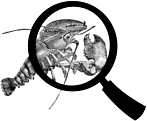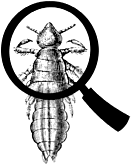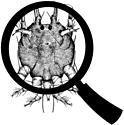The Book of Animal Ignorance (21 page)
Read The Book of Animal Ignorance Online
Authors: Ted Dewan
T
he name lobster comes from the Old English
loppestre
, the product of a collision between the Latin for locust (
locusta
) and
loppe
, Old English for spider. As arthropods, they are closely related to both. The best-known lobsters are the European and the American, but there are about fifty species including the Hunchback locust lobster, the Velvet fan lobster and the Musical furry lobster. Lobsters from 140 million years ago were so like today's that if you ate one for dinner you wouldn't notice the difference.
Lobsters are
peaceful, serious
creatures, who
know the secrets
of the sea, and
don't bark
.
GERARD DE
NERVAL
Lobsters are surprisingly fast swimmers: with a flex of their tail they can shoot along at 15 feet a second. Some have been tracked covering distances of over a hundred miles a year, in search of food and sex. Lobster sex involves a lot of undressing and urination. Like mice, they use their urine to communicate. Their two bladders are handily located in their heads, so urine can be mixed with water and squirted from their gills into the face of a potential mate. Male and female lobsters usually attack each other on sight, but, luckily, male lobsters find the urine of a moulting female arousing. Males wait in their rock shelters, urinating out of the doorway. Females approach when ready to moult, and urinate back at them. They have sex in the missionary position: the male props open the female's sperm pouch with his swimming legs and, after some leg-fanning foreplay, ejaculates gelatinous sperm capsules into her pouch. He protects her until her shell hardens â about two weeks later â and then hostilities resume.
ODD-CLAW ETIQUETTE
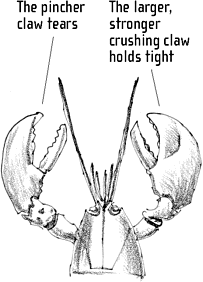
To grow, a lobster must shed its shell. Because the food-grinding teeth inside its stomach are part of the exoskeleton, it has to pull out the lining of its throat, stomach and anus to free
itself. Not all lobsters survive this process. It also makes it hard to tell their age. Many of the ones we eat are over twenty years old, but a big specimen can weigh as much as a labrador and may have lurked on the ocean floor for over a century.
Fighting lobsters lock crushing claws until one of them submits. Sometimes, they attack each other's antennae, legs, claws or eyes. A large crusher claw can exert as much as 1,000 lb per square inch on something small (like a human finger). To escape, they can jettison a limb using a special muscle at its base but because lobsters' blood flows through their body cavities, not veins, they will bleed to death unless leaks are sealed quickly. Legs, antennae and claws can regenerate, but not eyes.
As long as their gills are damp, lobsters can breathe. They will survive for up to a week out of water. French Romantic poet Gérard de Nerval used to take Thibault, his pet lobster, for walks in Paris using a blue ribbon as a lead.

Cooked lobsters are red because boiling transforms protein molecules in the shell into shapes that absorb everything except red light, which is reflected. There is no clear evidence about whether lobsters feel pain. Boiling water is probably the quickest method but there is no absolutely humane way of killing them.
L
ice are very small wingless insects, related to the bugs, aphids and cicadas. They live as parasites in the fur or feathers of mammals and birds, feeding on blood, dead skin or feather parts. Almost all animal species support one or two varieties, living on different parts of their body. Notable exceptions are bats, platypuses and echidnas, which are louse-free.
Humans carry three lice species: on our heads, our clothes and our pubes. By studying their DNA alongside those of other primates, we've learnt rather a lot about ourselves. The pubic louse (
Pthirus pubis
), for example, is very closely related to the gorilla louse (
Pthirus gorillae
). The DNA shows the two species split over three million years ago, so our hominid ancestors either occasionally slept with gorillas, or used abandoned gorilla nests as hammocks. Similar analysis of head lice (
Pediculus
humanus capitis
) tells us that we split from chimpanzees five and a half million years ago, and that we caught a second species from the heads of our now extinct cousins,
Homo erectus
, three million years later. Body lice (
P. humanus humanus
) live only on clothing and evolved from head lice about 70,000 years ago, thus telling us when we first started getting dressed.
THE LOUSE CANNON
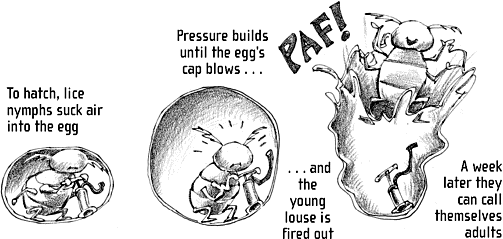
There is only one
species of louse that
is officially classified
as âendangered', the
pygmy hog sucking
louse (
Haematopinus oliveri
), attached to
the dwindling pygmy
hog population of the
Indian savannah
.
Adult lice look like tiny crabs, hence their nickname. They have powerful pincers on their front legs, which they use to anchor themselves close to their host's skin, by grabbing hair or feather barbs. The shape of some bird lice has evolved to fit exactly in between the barbs so they can't be removed by preening (which is why birds have dust baths).
Lice can't jump, so you need contact to catch them. Some bird lice hitch a ride with a passing fly if their host dies or becomes too crowded. As a means of distribution, this is risky, as they can't live on the fly. Most lice can only survive for a day or two if separated from their host. One of the least remarked-upon mass extinctions of recent times was that of the passenger pigeon louse,
Lipercus extinctus
. When the pigeons died out, so did the louse. Similarly, the programme to protect and breed Californian condors in captivity inadvertently destroyed the condor-chewing louse (
Colpocephalum californici
), when the remaining birds were all fumigated.
Sometimes lice do switch species. The dog louse (
Heterodoxus
spiniger
) infests dogs everywhere except Europe, but it evolved in Australia to feed on wallabies and only moved to dingos when they arrived with Indonesian fishermen 4,000 years ago.
Some lice are actively harmful: the faeces of the human body louse carry typhus and trench fever viruses. Analysis of the lice found on the buried remains of French soldiers who died in Napoleon's retreat from Moscow confirms that lice killed more of them than the Russians did.
The ânits' that children catch from each other are the eggs of the head louse, which the louse sticks to the base of the hair using a special cement. It's so strong that some females end up sticking themselves to a strand of hair and starving to death. They lay six eggs a day. The optimum population is about a hundred lice per head, which takes about a month to build up.
M
ites are tiny, eight-legged members of the spider clan but most are too small for us to see. After insects, they are the most diverse group of animals on the planet. We don't know how many species of mite there are; over 48,000 have been identified so far, but this is probably only a tenth of the total number. They can live almost anywhere, on land or sea, from the icy, sunless ocean depths to hot springs where the temperature would boil most other organisms. Only bacteria are more adaptable; mites can raise a family in the windpipe of the honey bee, or hitch lifts between flowers on the beak of a hummingbird. A single square foot of forest contains a million mites from over 200 different species.
IN-YOUR-
FACE
INCEST
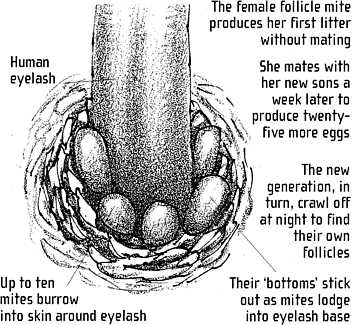
Not that you have to go as far as the woods. As you read this, the follicle mite,
Demodex folliculorum
, is using its needle-shaped jaws to feast on the oil from the sebaceous glands at the base of your eyelashes. Demodex mites look like chubby toothbrushes, with a long abdomen and four pairs of clawed legs. They burrow into the follicle headfirst and have a digestive system so efficient they don't produce any waste. When they die, they just dissolve
in situ
, with no harmful side effects.

Our homes are vast continents teeming with independent mite
kingdoms: flour mites, cheese mites, furniture mites, prune mites, mould mites, each feeding and reproducing in its own microhabitat. Probably the most infamous is the dust mite (
Dermatophagoides pteronyssinus
â or âskin-eating feather-stabber'). They don't feed on humans but on the flakes of skin that fall from our bodies. Considering each of us produces a small flour bag's worth of skin flakes a year, there's plenty for them to chew on. The musty smell that hits us when we empty our vacuum cleaner is caused by the digestive enzymes of dust mites: half a teaspoon of dust contains as many as a thousand mites and 250,000 pellets of their droppings. Although these droppings can aggravate asthma, caution is needed: dust mites do an important job ridding our environment of scurf and dander. Also, they are
impossible
to remove in the long term. Obsessive vacuuming just redistributes them and their eggs around the house and, worse still, sucks up their main predator, the larger
Cheyletus
mite that helps keep their population stable. Carpet cleaning is an even happier prospect: it creates just the warm, moist conditions in which they thrive (which is why they like our mattresses so much).
Demodex means âlard
worm'. The notorious
nineteenth-century
biologist Sir Richard
Owen, better-known for
inventing the term
âdinosaur',
named it
.
That's not to undermine the threat posed by mites and their subfamily, the ticks. They carry viruses on their bodies and in their saliva which cause scabies, Lyme disease, dermatitis and typhus in humans and mange in animals; a single species,
Varroa
destructor
, came close to wiping out the world's honey bee population. By far the largest number of mite species feed on plants and their effect on crops can be devastating, causing billions of pounds worth of damage each year. But the mites' diversity may their Achilles' heel. Even mites themselves have mites. In 2001, the green mite that had decimated the African cassava crop was arrested by the import of a predatory mite from Brazil, the plant's original home.
